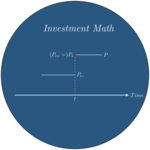Volatility Accounting (1)
In this post, I shed some light on the volatility of the price process of a zero coupon equity contract. The aim is to understand how the volatility of prospective expected returns impacts the volatility of the price process. I derive under a specific condition1 a simple accounting relationship linking price volatility on one hand and cash flow as well as discount factor volatility on the other hand. There is some empirical presumption that markets exhibit excess volatility, i.e. that market prices are more volatile than warranted by cash flow volatility. Under the afore mentionned condition, this requires that discount rate shocks be negatively correlated with cash flow shocks2.
Accounting for volatility
It was shown at the end of this post that the volatility of the price process \((P_{t})_{t \in [0,T]}\) was equal to that of the martingale \((Y_{t})_{t \in [0,T]}\) with \(Y_{t}=E_{t}[\exp(-\int_{0}^{T}r_{u}du)X_{T}]\). We want to understand how this relates to the volatility of the fundamental solution, i.e. the volatility of \((X_{t})_{t \in [0,T]}\) with \(X_{t}=E_{t}[X_{T}]\). To be clear, volatility is meant here as the integrand of the stochastic integral in the geometric representation of each process. For instance, the volatility of the martingale \((X_{t})_{t \in [0,T]}\) is the process \((\eta_{t})_{t \in [0,T]}\) such that:\[\frac{dX_{t}}{X_{t}}=\eta_{t}dB_{t}.\]
We want to relate the volatility \(Z\) of \(P\), i.e. the volatility of the martingale \(Y\), with the volatility of the martingale \(X\) and that of the martingale \(R=(E_{t}[\exp(-\int_{0}^{T}r_{u}du)])_{t \in [0,T]}\). By definition, these martingales follow drift-less diffusions with the relevant terminal conditions:
- \(X\): \(dX_{t}=X_{t}\eta_{t}dB_{t}\), with terminal value \(X_{T}\),
- \(R\): \(dR_{t}=R_{t}\nu_{t}dB_{t}\), with terminal value \(\exp(-\int_{0}^{T}r_{u}du)\),
- \(Y\): \(dY_{t}=Y_{t}Z_{t}dB_{t}\), with terminal value \(\exp(-\int_{0}^{T}r_{u}du)X_{T} \qquad (1)\) ,
Now the process \(XR\) follows (Ito): \[d(X_{t}R_{t})=X_{t}R_{t}\eta_{t}dB_{t}+X_{t}R_{t}\nu_{t}dB_{t}+X_{t}R_{t}\eta_{t}\nu_{t}dt\] and has the same terminal condition as \((1)\). It does not define a martingale given that the drift term is not equal to zero. It is therefore not a solution to \((1)\). We can however easily modify this process to solve \((1)\) when the following assumption holds:
Assumption H: Both volatility processes \((\eta_{t})_{t \in [0,T]}\) and \((\nu_{t})_{t \in [0,T]}\) are deterministic
Indeed, consider the process \(W_{t}=X_{t}R_{t}\exp(-\int_{t}^{T}\eta_{u}\nu_{u}du)\) under this assumption. This is a well defined adapted process because although all terms in the exponential relate to the future, they are deterministic and therefore do not involve future shocks. The Ito rule implies:\[dW_{t}=W_{t}(\eta_{t}+\nu_{t})dt,\] and obviously we have \(W_{T}=X_{T}R_{T}=\exp(-\int_{0}^{T}r_{u}du)X_{T}\). We have thus identified the martingale representation of \(Y_{T}\) and therefore the volatility process of P:\[Z_{t}=\eta_{t}+\nu_{t}.\]
Proposition: Price volatility \(Z_{t}\) is under Assumption H the sum of fundamental volatility \(\eta_{t}\) and discount factor volatility \(\nu_{t}\).
The meaning of ‘discount factor volatility’ can be clarified further. Discount factor volatility is the volatility \((\nu_{t})_{t \in [0,T]}\) of \(R\). It is tied to the integral representation:\[\exp(-\int_{0}^{T}r_{u}du)=E_{0}[\exp(-\int_{0}^{T}r_{u}du)]+\int_{0}^{T}E_{u}[\exp(-\int_{0}^{T}r_{w}dw)]\nu_{u}du.\] In addition, we have: \[E_{t}[\exp(-\int_{0}^{T}r_{u}du)]=E_{0}[\exp(-\int_{0}^{T}r_{u}du)]+\int_{0}^{t}E_{u}[\exp(-\int_{0}^{T}r_{w}dw)]\nu_{u}du.\] Injecting this identity in the above equation and dividing the result by \(\exp(-\int_{0}^{t}r_{w}dw)\), we get: \[\exp(-\int_{t}^{T}r_{u}du)=E_{t}[\exp(-\int_{t}^{T}r_{u}du)]+\int_{t}^{T}E_{u}[\exp(-\int_{t}^{T}r_{w}dw)]\nu_{u}du\] which is the martingale representation of \(\exp(-\int_{t}^{T}r_{u}du)\). It entails the volatility process \((\nu_{u})_{u \in [t,T]}\). The quantity \(\nu_{t}\) can thus the be interpreted as the elasticity (the log derivative) of \(\exp(-\int_{t}^{T}r_{u}du)\) to the shock \(dB_{t}\).
We saw in this post that the market price has the following representation: \[P_{t}=E_{t}[\exp(-\int_{t}^{T}r_{u}du)X_{T}].\] Intuitively, this suggests that the elasticity of \(P_{t}\) to \(dB_{t}\) either arises from that of \(X_{T}\) or from that of \(\exp(-\int_{t}^{T}r_{u}du)\). This thus turns out to be true under Assumption H.
Excess volatility
I assume now that fundamental volatility \(\eta_{t}\) is positive. This is just a normalization3 which ensures that positive Brownian shocks raise the expectation of the terminal payoff. Given the above proposition, we now have two polar cases:
If \(\nu_{t}\) is positive, price volatility is greater than fundamental volatility \(Z_{t}=\eta_{t}+\nu_{t} \geq \eta_{t}\). This requires that a positive cash flow shock raises the prospective discount factor \(\exp(-\int_{t}^{T}r_{u}du)\), i.e. lowers the cumulated prospective return.
If \(\nu_{t}\) is negative, price volatility is lower than fundamental volatility \(Z_{t}=\eta_{t}+\nu_{t} \leq \eta_{t}\). This requires that a positive cash flow shock lowers the prospective discount factor \(\exp(-\int_{t}^{T}r_{u}du)\), i.e. raises the cumulated prospective return.
The former situation is called excess volatility. A story rationalizing excess volatility is as follows. When negative cash flow news hits the market, the price of the fundamental solution falls to reflect the lower cash flows. Yet this also spooks investors who require a greater expected return on the contract to hold it. The prospective return therefore rises and this amplifies the price move downwards. The reverse effect occurs on the upside.
Links
Deterministic volatilies (see Assumption H). A later post will extend the volatility identity to a more general context.↩︎
Although natural, this condition is not strictly equivalent to excess volatility. This will be detailed in a later post.↩︎
If \(\eta_{t}\) was negative, we would just redefine the underlying Brownian to be \(W=-B\). This change of sign preserves the Brownian property.↩︎
